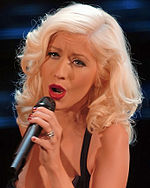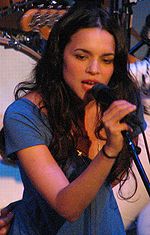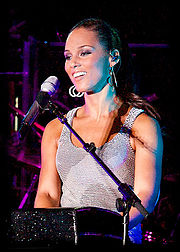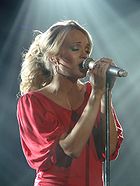- Music history of the United States in the 2000s
-
United States music history - Colonial era
- to the Civil War
- During the Civil War
- Late 19th century
- Early 20th century
- 1940s and 50s
- 1960s
- 1970s
- 1980s
- 1990s
- 2000s
- 2010s
Ethnic musicUnited States Popular music of the United States in the 2000s saw two major developments. The dominance of bubblegum pop like *NSYNC (No Strings Attached) and Backstreet Boys (Backstreet's Back) continued from the 90s, and also grew to include Latin stars like Shakira (Laundry Service), Ricky Martin (Sound Loaded) and Christina Aguilera (Christina Aguilera). In addition to these slick sounds, a growing number of domestic and foreign garage rock bands have achieved notable success, including The Strokes (Is This It?) and the White Stripes (White Blood Cells). Also, with the increasing popularity of online catalogs of music, (such as iTunes, Rhapsody, and Amazon) there has been a rise in niche and independent music.
A return to the roots of American country-rock music is slowly becoming an American music trend as artists like Brandi Carlile emerge. Also, with the echo boom generation taking over, more music is starting to influence the music of baby boomers and many teenagers and young adults are starting to be interested in music from older decades, especially the 1960s, 1970s, and 1980s.
Other styles that emerged in the 2000s includes a newer form of hip-hop, which is more melodic and has cleaner themes than the older hip-hop that was dominant in the 1980s and 1990s. Examples of those include snap music and crunk, and the rise of emo and pop-punk, which had been rising since the late 1990s.
Contents
Hip hop
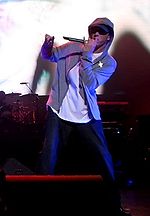 Eminem is considered the biggest hip-hop act of the decade as well as the best-selling overall music artist.
Eminem is considered the biggest hip-hop act of the decade as well as the best-selling overall music artist.
Hip hop dominated popular music in the 2000s. Artists such as 50 Cent, Eminem, OutKast, The Black Eyed Peas, T.I., Kanye West, Nelly, Nas, Jay-Z, Missy Elliott, Lil Wayne, The Game and Ludacris were among the dominant mainstream hip hop artists to have represented the hip hop genre for the decade. Distinct regional differences also developed outside of the hip hop/rap strongholds of the 1990s, New York City and Los Angeles.[1]
During the 2000s Eminem, who is perhaps best known for being one of the few successful white rappers in the music industry, enjoyed a massive commercial success and maintained commercial relevance by attempting to be controversial and subversive. According to Billboard, Eminem has two of his albums among the top five highest selling albums of the 2000s. After the release of his album, Relapse, Eminem became the best selling rapper of all time.[2]
Alternative hip hop, almost unknown in the mainstream, except for a few crossover acts, evolved throughout the decade with the help of artists such as Mos Def, The Roots, Atmosphere, Aesop Rock, and Common, who achieved unheard-of success for their field. Throughout the 2000s, Alternative Hip hop continued its philosophical, positive, and complex lyrical subject matter, while denouncing materialism, fashion, and money. This sub-genre also includes a lot of spoken word and a branch of slam poetry. The sub-genere could be said to be related to both the old school hip-hop culture of the 1980s and 1990s, and the indie rock and hipster subcultures.
Southern hip-hop became mainstream in the mid to late 2000s. Artists like Lil Jon, Flo Rida, Rich Boy, Rick Ross, T.I., Young Jeezy, and Lil Wayne were popular artists of the sub-genre in the 2000s. Ringtone rap, a term used by some people[who?] to describe rap and R&B singles that lacked musical value and focused on using catchy hooks and beats as gimmicks for ringtone sales and top 40 airplay, was popular during the second-half of the decade. Examples of rappers referred to as ringtone rap artists include Soulja Boy, Lil' Wayne, DJ Unk, Mims, Crime Mob, Hurricane Chris, D4L, and Lil Jon. Rapper Jay-Z described it as the "new hip-hop". The ringtone rap trend declined by the end of the decade as the popularity of ringtones dropped.[3]
Auto-Tune became popular by mid-2007, with hip-hop artist T-Pain starting the craze. AutoTune was popular in the earlier part of the decade as well, but it was used as an effect than a major replacement of the standard human voice. The Black Eyed Peas began utilizing auto-tune and electropop–dance in their most successful album to date, The E.N.D., which spawned five top ten hit singles: "Boom Boom Pow", "I Gotta Feeling", "Meet Me Halfway", "Imma Be", and "Rock That Body".
Rock
Rock remained popular in the beginning of the decade, despite the increasing popularity of hip-hop, but experienced a diminished presence on mainstream music charts by the end of the decade. Modern rock as a radio format experienced a sharp decline, with high-profile cornerstone stations like WLIR-FM, K-Rock in New York City and WBCN in Boston flipping to other formats. New York City, once the leading market for the format, has only one modern rock station, 101.9 WRXP-FM.
Alternative rock and Indie rock
Garage rock and post-punk revival
 The White Stripes were one of the most successful emerging American rock acts of the decade.
The White Stripes were one of the most successful emerging American rock acts of the decade.
In the early 2000s, a new group of bands emerged into the mainstream which drew primary inspiration from post-punk and new wave and were variously characterised as part of a garage rock, post-punk or new wave revival.[4][5][6][7] Because the bands came from across the globe, cited diverse influences (from traditional blues, through new wave to grunge), and adopted differing styles of dress, their unity as a genre has been disputed.[8] There had been attempts to revive garage rock and elements of punk in the 1980s and 1990s and by 2000 scenes had grown up in several countries.[9] The Detroit rock scene included The Von Bondies, Electric Six, The Dirtbombs and The Detroit Cobras[10] and that of New York which included Radio 4, Yeah Yeah Yeahs and The Rapture.[11] Social networking sites such as MySpace and Purevolume enables amateur artist to promote their music, and thanks to the internet, many underground unsigned artists become discovered and listen to by alternative communities.
Two of the most successful bands from these scenes were The Strokes, who emerged from the New York club scene with their début album Is This It (2001) and The White Stripes, from Detroit, with their third album White Blood Cells (2001).[12] They were christened by the media as the "The" bands, and dubbed "The saviours of rock 'n' roll", leading to accusations of hype.[13]
A second wave of American bands that managed to gain international recognition as a result of the movement included Black Rebel Motorcycle Club, The Killers, The Black Keys, The Bravery, Interpol, Kings of Leon and Spoon.[14]
Post-grunge
 Nickelback has released seven number-one singles on the Mainstream Rock Tracks chart and has sold over 35 million records.
Nickelback has released seven number-one singles on the Mainstream Rock Tracks chart and has sold over 35 million records.
After the first wave of post-grunge bands lost their popularity, bands like, Puddle of Mudd and Nickelback took post-grunge into the 21st century with considerable commercial success, abandoning most of the angst and anger of the original movement for more conventional anthems, narratives and romantic songs. They were followed in this vein by new acts including Shinedown, Seether and 3 Doors Down, who combined post-grunge with country music and Southern rock.[15]
In addition, some of the most successful Post-grunge bands in the 1990s, such as Foo Fighters and Creed, also continued their success during the 2000s.
Indie rock
During the mid 2000s, bands such as Modest Mouse and Fleet Foxes released indie rock albums that broke into the mainstream and gave Indie rock recognition. The late 2000s also saw more Indie Rock bands such as MGMT, LCD Soundsystem, Animal Collective, Grizzly Bear, and Vampire Weekend gain popularity around the world, including the United States, thanks to the rise of independent internet music blogs. The rising popularity of Internet radio has led to high album sales, despite little or no radio play for Indie rock bands.
Hard rock and heavy metal
During the early 2000s a new wave of metal began with interest in the newly emerging genre nu metal and genres of a similar style such as rap metal and the later mainstream success rap rock. The popularity of nu metal music carried over from the late 1990s, where it was introduced by early work from bands such as Korn, Deftones, Limp Bizkit, Slipknot and Coal Chamber, into the early 2000s with the similar genre, rap rock, bringing in a wave of monster-hit artists such as System of a Down, Evanescence, Staind, Papa Roach, and Disturbed. The success of Korn's third studio album, Follow The Leader, brought nu metal to the mainstream. Linkin Park's debut album Hybrid Theory, released in 2000, sold over 29 million copies worldwide. The band's next album Meteora is the most successful album on the Modern Rock Tracks chart. However, by 2002 and 2003, there were signs that nu metal's mainstream popularity was weakening.[15] Crazy Town's second album Darkhorse, Korn's long awaited fifth album Untouchables, Limp Bizkit's fourth album Results May Vary, Linkin Park's second album Meteora, Papa Roach's second album Lovehatetragedy, P.O.D.'s third major-label album Payable on Death and Static-X's third album Shadow Zone did not sell as well as their previous releases, mainly because those groups had changed their sound, while nu metal bands were played more infrequently on rock radio stations and MTV began focusing on pop punk and emo bands such as Good Charlotte and Fall Out Boy, respectively.[16] Since then, many bands have changed to a more conventional music sound, such as hard rock (30 Seconds to Mars, Papa Roach), post-grunge (Staind), heavy metal (Slipknot, Disturbed, Static-X), alternative rock (Linkin Park, Adema), or alternative metal (Korn, Mudvayne, Deftones, Godsmack, System of a Down) in order to maintain their popularity and their fanbases. A primary example of this is Linkin Park's 2007 album Minutes to Midnight which showcases a softer alternative rock sound as compared to their earlier, more aggressive material.[16]
AC/DC released Stiff Upper Lip in 2000 and Black Ice in 2008, their first album in eight years. Guns N' Roses released the long-awaited Chinese Democracy in 2008 after over a decade of work by Axl Rose. Metallica released two albums in the 2000s, St. Anger in 2003 and Death Magnetic in 2008. Aerosmith released the platinum-selling Just Push Play in 2001 followed by the blues-infused Honkin' on Bobo in 2004; the band also toured every year of the decade except 2008. Bon Jovi released five albums during the decade: Crush (2000), Bounce (2002), Have a Nice Day (2005), Lost Highway (2007), and The Circle (2009). Crush fared best, going double platinum, and spawning the hit "It's My Life", while Have a Nice Day and Lost Highway also launched Top 40 singles, went platinum, and saw the band mix hard rock with country. Bon Jovi's Lost Highway Tour was the highest-grossing tour of 2008.
By 2004 the uprising genre metalcore dominated with bands such as Killswitch Engage, Underoath, Bullet for My Valentine, and most successfully Avenged Sevenfold, all releasing successful albums. The rise of metalcore led to increased popularity and exposure of nearly every other sub-genre of heavy metal including death metal, black metal, and thrash. Innovations in the 2000s included the advent of technical death metal, folk metal, and deathcore.
Pop punk
A second wave of pop punk bands emerged in the 2000s such as Good Charlotte, New Found Glory, and Sum 41, who made use of humour in their videos and had a more radio-friendly tone to their music, while retaining the speed, some of the attitude and even the look of 1970s punk.[17] More recent pop-punk bands, including Simple Plan, The All-American Rejects and Fall Out Boy, have a sound that has been described as closer to late 1970s and early 1980s hardcore, with similarities to the band Cheap Trick, while still achieving considerable commercial success.[17] More 1980s and 1990s influenced pop-rock and pop-punk bands emerged into the mainstream punk circa 2008, which were popularity with the Vans Warped Tour, included artists such as Forever The Sickest Kids, The Summer Set, The Maine, We The Kings, Boys Like Girls, Attack Attack, and so on. This continues into the 2010s.
In addition, some of the most successful pop-punk bands in the 1990s, such as Green Day, Weezer, Blink-182 and The Offspring, also continued their success during the 2000s.
Emo
Emo broke into mainstream culture in the early 2000s with the platinum-selling success of Jimmy Eat World's Bleed American (2001) and Dashboard Confessional's The Places You Have Come to Fear the Most (2003).[18] The new emo had a far greater appeal amongst adolescents than its earlier incarnations.[18] At the same time, use of the term "emo" expanded beyond the music world, becoming associated with fashion, hairstyle, and other aesthetic attributes of culture.[19]
In recent years the term emo has been applied by critics and journalists to a variety of artists, including multi-platinum acts such as Fall Out Boy[20] and My Chemical Romance[21] and disparate groups such as Paramore[20] and Panic at the Disco,[22] even when they protest the label.
The popularity of emo music peaked in 2005-2006.[23]
Pop
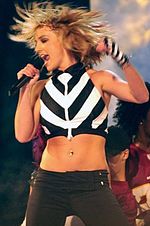 Singer Britney Spears was the best selling female performer of the 2000s.
Singer Britney Spears was the best selling female performer of the 2000s.
Teen pop continued to be an extremely popular genre in the early 2000s with success of teenage pop-singers Britney Spears and Christina Aguilera. Britney's "Oops!...I Did It Again" and Christina's "Come On Over Baby (All I Want Is You)" become huge hits in the year 2000. By 2001, however, the teen-pop trend dissolved dramatically due to modern R&B and hip-hop influenced music that later dominated throughout the middle of the decade. Britney Spears's 2001 album Britney and Christina Aguilera's 2002 album Stripped are examples of teen pop artists transitioning from teen pop to more grown-up, modern R&B influenced records.
Boy bands continued their popularity during the beginning of the decade but their popularity also faded, with the exception of Backstreet Boys, as they continued with popularity and achieved record sales close to 200 million including over 120 million albums, including strong sales of their 2001 release, Black & Blue. Many fans of the boy band era collect their albums for nostalgia still giving revenue to these artists. By 2002, records by boy bands were very sparse on the Billboard Hot 100. Some members of boy bands went on to have successful solo careers, such as Jesse McCartney from Dream Street and Justin Timberlake from 'N Sync. A new strain of boy bands, such as V Factory, Varsity Fanclub, Click Five, NLT, and the Jonas Brothers, took place at the end of the decade, but the boy band trend did not become as glamorized as it was at the beginning of the decade, with an exception for the Jonas Brothers. Girl groups kept their popularity through the 2000s, with groups such as Destiny's Child, Pussycat Dolls, Danity Kane, Paridiso Girls, and Girlicious, but they were not as successful as the boy bands. Disney executives created girl groups as well, such as The Cheetah Girls and No Secrets.
After 9/11, a new "teen pop-rock" movement began. While girl pop-rock singers such as Alanis Morissette and Jewel were popular in the 1990s, they had declined in popularity after 1998 when the pop princesses such as Britney Spears debuted. Avril Lavigne was arguably the first and lead artist to take this new direction in pop music, with hits such as "Complicated", "Sk8er Boi", "I'm with You" at the beginning of the decade and "Girlfriend" at the end Lavigne leads this genre throughout all the decade worldwide, her contemporaries such stars as, Michelle Branch and Vanessa Carlton not far behind with their own success. Other prominent girl pop-rock artists of the 2000s included Pink, Hilary Duff, and Ashlee Simpson. Later artists reflecting the genre include Selena Gomez, Demi Lovato, Miley Cyrus, Katy Perry and Taylor Swift.
In 2001, triple-threat entertainer Jennifer Lopez debuted at number one on the U.S. Billboard 200 and the Top R&B/Hip-Hop Albums chart with her J.Lo album and in addition her film, The Wedding Planner, opened at number one at the box office at the same time making her the first actress and singer in history to have both a film and an album at number one in the same week.
Artists such as Janet Jackson, Kylie Minogue and Madonna experienced revived success. Justin Timberlake shot to stardom with his Justified album. In 2005, Cher ended her 3-year long "Farewell Tour" which became the highest grossing female and solo tour at that time.
American Idol winners become a big part of the American pop sound, but only one winner became a staple. Kelly Clarkson experienced huge success and tons of hit radio singles with her pop-rock sound including worldwide hits "Breakaway", "Since U Been Gone", "Behind These Hazel Eyes", and "Because of You" at the middle of the decade.
Lady Gaga took the later part of the decade by storm and revived the electronic influence of pop music that was not prominent since 2000. Her debut album, The Fame, was released on August 19, 2008. It reached number-one in Canada, Austria, Germany, United Kingdom and Ireland and topped the Billboard Top Electronic Albums chart. Its first two singles, "Just Dance" and "Poker Face", became international number-one hits, topping the Hot 100 in the United States as well as other countries. The album later earned a total of six Grammy Award nominations and won awards for Best Electronic/Dance Album and Best Dance Recording. By the fourth quarter of 2009 she had released her second studio album The Fame Monster, with the global chart-topping lead single "Bad Romance".
Internet personalities (people whom were primarily famous as a result of the Internet) such as Justin Bieber and Soulja Boy Tell Em enjoyed success in the pop charts. During the 2000s many different internet personalities were discovered by fans on the internet, and as a result were signed and gained much success in the charts.
 American Idol winner Kelly Clarkson makes huge hits in pop music charts and over 20 million records, best-selling Idol.
American Idol winner Kelly Clarkson makes huge hits in pop music charts and over 20 million records, best-selling Idol.
In 2001 Michael Jackson, one of popular music's most successful artists of all-times, released his final studio album Invincible before his death, though it did not receive a lot of exposure. Michael Jackson died in June 2009, creating the largest public mourning since the death of Diana, Princess of Wales in 1997.[26][27][28]
Children's music rises significantly in sales, especially with Disney (The Cheetah Girls, High School Musical, Hannah Montana: The Movie, and The Jonas Brothers among others). All The Cheetah Girls, High School Musical and Hannah Montana albums were among the best-sellers of 2006 and 2007 and reached the number 1 position, left many artists produced by Disney in the 2000s, The Cheetah Girls, Hilary Duff, Selena Gomez, Miley Cyrus, Jonas Brothers, Raven-Symoné, the artists of the best-selling Disney's decade of 2000s.
The musical style of the 1980s influenced pop music to some extent in the later stages of the decade, as seen in Rihanna's hit "S.O.S." (a sampling of Soft Cell's "Tainted Love"), "She's Like The Wind" by "Lumidee" and Flo Rida's "Right Round", a reworking of the Dead or Alive hit "You Spin Me Right Round". Other hits include Aaron Carter's cover of Bow Wow Wow's "I Want Candy", and Britney Spears' covers of "My Prerogative" and "I Love Rock 'n' Roll". Pop rock groups such as Metro Station and Owl City display 80s influences. Beyoncé's hit "Sweet Dreams" was not a direct sampling of an 80s pop hit but Anne Hagerty of Billboard magazine was quoted saying; "this track will fit rite on a Michael Jackson or Madonna instrumental. Alien Ant Farm successfully covered Michael Jackson's "Smooth Criminal", and Fall Out Boy came out with their own cover of "Beat It", later on. Bowling for Soup had a hit with "1985".
Adult contemporary
Adult contemporary music (also known as "soft rock" or "lite-rock"), began to somewhat decrease in popularity starting in the late '90s (due to the increasing popularity of Top 40 music) into January 2000 until September 11th, 2001. After 9/11, popularity for Adult Contemporary Music (as well as Contemporary Christian Music crossovers) increased tri-fold during the grieving process, when the 25-44 Conservative Female Demographic favored listening to songs with appropriate, positive and uplifting lyrics containing love and hope. Upon the eventual return back to normalcy after 9/11, the popularity of Adult Contemporary music held steady until about 2003, when Billboard began to change their chart formats. This led to Adult Contemporary stations to program their music "not-as-soft" or "cheesy" as they used to, and ended up substituting the words "soft-rock" with "lite-rock", which has a more modern-edged connotation. Yet, AC stations remained careful to not cross the Adult Top 40 format line. Because of all these changes, AC Stations slowly increased in popularity.[citation needed]
In the late 2000s, artists like Coldplay, Daughtry and Gavin Rossdale were finding more success crossing over onto the Adult Contemporary charts.
On the female side, artists like Sara Bareilles, Colbie Caillat, Diana Krall, Norah Jones, Kelly Clarkson, Alicia Keys, and Leona Lewis continued to find crossover success on the Adult Contemporary charts as well. AC veterans such as Celine Dion, Rod Stewart, Phil Collins, The Eagles, Alanis Morissette and Sheryl Crow continued to release music only on the Adult Contemporary formats. There are three songs which experienced longevity atop the chart, "Love Song" by Sara Bareilles, "Bubbly" by Colbie Caillat, and "Breakaway" from Kelly Clarkson spent a longevity 20 weeks atop the chart.
Alicia Keys is considered the greatest singer of R&B of the decade with 30 million records worldwide, scored more hits in the U.S. charts got seven numbers each of the Hot R&B/Hip-Hop Songs and four numbers in a Billboard 100, and she shares the record with Britney Spears, being the only female singers to have their first four albums debuting in first place in the chart Billboard Hot 200.
Norah Jones is considered[who?] the greatest Jazz singer of the decade with 37 million records worldwide, she broke worldwide in 2003, a year after releasing her debut album Come Away With Me with 10 million copies in United States of America is the world sold 20 million copies, her second album has the record for the biggest selling album in one week with 1,900,000 million copies sold, is in the late released two more albums bestsellers, 3 albums debuting in the Billboard 200 and won 8 Grammys with debut album and in total won 12 Grammys during the decade.
Contemporary R&B
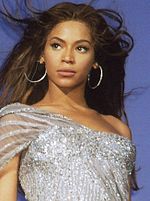 Beyoncé Knowles is one of the best selling female performer of 2000s.
Beyoncé Knowles is one of the best selling female performer of 2000s.
The continued popularity of contemporary R&B was seen during this decade in the global success of established artists such as Beyoncé, Mariah Carey, Jennifer Lopez and Usher, whose careers began in the 1990s and continued in the dawn of the new millennium. The year 2001, in particular its summer, has been described as a golden age for contemporary R&B and urban soul music, with artists such as Jill Scott, Mariah Carey and Destiny's Child, who paved the way for Alicia Keys, Blu Cantrell, and the revival of Aaliyah.[29][30]
Jennifer Lopez 2000s R&B Singer. Selling over 35 million records worldwide album.
Beyoncé Knowles, Michelle Williams and Kelly Rowland, better known as Destiny's Child is the most successful female R&B group of all time, selling over 50 million records worldwide during the 2000s. The group has many chart topping singles worldwide, such as "Survivor", "Say My Name" "Bootylicious","Independent Women Part 1",and "Jumpin'Jumpin'.
Other emerging acts from the early 2000s include Ashanti, Rihanna and Ciara.[31]
R&B artist Robin Thicke Topped the R&B Charts with his hit single "Lost Without U". He was the first white artists to top these charts since George Michael. His album "The Evolution of Robin Thicke" went on to be certified platinum by the RIAA.
Musical Artist Usher released the album "Confessions" which went on to become the best selling album of 2004 and the second best selling album of the 2000s. Confessions is now certified Diamond by the RIAA.
Country
Country slipped in mainstream popularity in the early 2000s, due partly to the public retirement of Garth Brooks and partly due to a growing discontent among some traditional country music fans and artists over the perceived direction and sound of the genre. But, the upper part of the Billboard 200 all-genre album chart frequently had albums recorded by country music artists listed; several of those titles were certified double platinum or better, indicating the genre continued to have a strong niche in the music industry.
One of the most successful new artists of the decade was Carrie Underwood. In 2005, the Checotah, Oklahoma, native became the first American Idol winner to record primarily country music, instead of pop, rap or rhythm and blues. Although several of her songs did enjoy crossover popularity, Underwood had amassed eight No. 1 songs on the Billboard Hot Country Songs chart by the end of the decade, along with numerous awards from the Country Music Association, Academy of Country Music and others.
Country pop, a subgenre which has its roots in the Nashville Sound of the late 1950s-early 1960s, continued to flourish in popularity. The most prominent act was Shania Twain, with her album Up!, released in 2002, Other top performers in the genre included Dixie Chicks, Lonestar, Martina McBride, Tim McGraw, Faith Hill, Keith Urban and Rascal Flatts. In the middle of the decade, an informal group of singers and songwriters called the MuzikMafia formed to promote their mesh of honky-tonk and outlaw brand of country music; the most prominent members were "Big" Kenny Alphin and John Rich (of the duo Big & Rich) and Gretchen Wilson, who enjoyed success in the middle part of the decade.
Many non-country artists enjoyed success in the country music during the 2000s. The most successful of these artists has been former Hootie & the Blowfish lead singer Darius Rucker, who had three No. 1 hits in 2008-2009: "Don't Think I Don't Think About It", "It Won't Be Like This for Long" and "Alright." The Eagles, a California-based country-rock group, had their first major success on the Hot Country Songs chart in more than 30 years in 2007-2008 with the songs "How Long" and "Busy Being Fabulous." Other non-country artists who had success in the genre were Kid Rock, Sheryl Crow, Robert Plant, Jewel, Jessica Simpson, Bon Jovi and Miley Cyrus.
In the late 2000s, teenager Taylor Swift became the first country artist to enjoy widespread mainstream popularity since the 1980s, when artists including Dolly Parton, Eddie Rabbitt and Kenny Rogers regularly recorded music that appealed to both country and pop audiences. Two of Swift's songs — "Love Story" and "You Belong With Me" — both reached the top 5 of the Billboard Hot 100 (and No. 1 on several of the Hot 100's component charts) after topping the Hot Country Songs chart. At the 2009 MTV Video Music Awards, Swift became the first country artist to win a VMA award when she won in the Female Best Video category for "You Belong With Me."
Not everyone celebrated the success of artists such as Underwood and Swift, reflecting the continued discontent and debate over what constituted "real" country music, a debate that had been on and off since the 1970s. Despite the fact that country music songs had long been crossing over to pop radio (and charting since the start of the Billboard charts in 1940), some critics contended that the pop-oriented sound was little more than repackaged pop music. In 2009, legendary country music artist George Jones proclaimed that "they've (the new artists) stolen our identity. ... They had to use something that was established already, and that's traditional country music. So what they need to do really, I think, is find their own title, because they’re definitely not traditional country music."[32] In addition, several forums, including the classic country-oriented Pure Country Music Web site, regularly included posts that were openly critical of artists such as Swift and Rascal Flatts.[33] Songs such as "Murder on Music Row" (by George Strait and Alan Jackson) and "Too Country" (by Brad Paisley) gained widespread acceptance and radio airplay, despite criticism in the lyrics over the eschewing of traditional sounds by radio programmers.
However, traditional country music retained a large following during the decade, thanks to the ongoing successes of veteran artists such as Strait, Jackson, Reba McEntire, Brooks & Dunn, Toby Keith and Kenny Chesney, and newer artists such as Paisley, Blake Shelton and Billy Currington. Rogers, Parton and Willie Nelson, all artists who had No. 1 country hits as far back as the early 1970s, all had No. 1 songs during the 2000s decade — either as soloists (Rogers), as part of one-time duo pairings (Nelson) or as featured background vocalists (Parton). McEntire's success came with two albums hitting No. 1 on the all-genre Billboard 200 albums chart (Reba Duets and Keep On Loving You ), and at the end of the decade had her biggest hit of her career ("Consider Me Gone"). In addition, veteran songwriters such as Bill Anderson and Bobby Braddock also enjoyed continued success with newly written songs. Late in the decade, newcomers such as Jamey Johnson and Miranda Lambert were widely hailed for their songwriting and performance talents.
The legendary group Alabama retired from touring in 2004 after nearly a quarter century of mainstream success, primarily during the 1980s and 1990s. Its band members — cousins Randy Owen, Teddy Gentry and Jeff Cook; and drummer Mark Herndon — remained active performers and recorded a successful series of albums containing gospel and traditional old-time songs.
Many legendary country music figures died during the decade. Some of the more prominent names included Waylon Jennings, June Carter Cash, Johnny Cash, Buck Owens, Hank Thompson, Porter Wagoner and Eddy Arnold.
Electronic music
In Europe, Trance was popular in the early part of the 2000s but this style diminished towards the mid 2000s. Hard House became the next big craze after trance in 2001, with a certain amount of cross-over between the two genres (in some cases creating Hard Trance tracks). As a kind of backlash, ambient, Chillout music achieved mainstream popularity in the early 2000s, with a successful market of chillout compilations and the genre even making it into television commercials and soundtracks.
Disco House and Funky House, popular in the late 1990s, continued to be successful through to the mid-2000s, before the sound of Electro House developed around 2006. The electro sound began to merge with other genres such as Hip Hop as the decade drew to a close.
In 2007 and later, dance music started gaining popularity in North America with dance-pop hits by artists such as the pop singer Rihanna's song "Don't Stop the Music" and "Disturbia". In 2008 and 2009 electro-pop and Nu-disco make an increase in popularity in North America and replaced hip-hop and R&B as the dominant genres of music with artists such as Britney Spears, Beyoncé, and Lady Gaga bringing this style to great popularity towards the end of the decade. The first traces of electropop has taken place in late 2006 with artists such as hellogoodbye and Timbaland. Furthermore, Madonna's singles such as "Hung Up" (#1 in 45 countries) and "4 Minutes" (#1 in 32 countries) become huge dance hits. (See hip hop, urban pop and R&B above for more information.) Pop duo Aly & A.J. explored electropop in their second album "Insomniatic". In addition, some of the most successful Electronica American artists and DJs in the 1990s, such as Moby and The Crystal Method, also continued their success during the 2000s.
Also, in the late 2000s a new era is emerging that embodies rave music called Dubstep. Dubstep is characterized by a tempo between 130 and 145 BPM, heavy sub-bass, and a distinct "wobbly" bass line. It often has a "dark" sound and features more heavy sampling than previous electronic styles, as most of its young producers have grown up during hip hop's mainstream hey-day. While a very new genre, it is particularly popular in Southern California.
Jazz
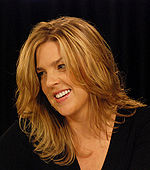 Diana Krall, 2007
Diana Krall, 2007
In the 2000s, straight-ahead jazz continued to appeal to a core group of listeners. Well-established jazz musicians, such as Dave Brubeck, Wynton Marsalis, Sonny Rollins, Wayne Shorter and Jessica Williams, continue to perform and record. In the 2000s, a number of young musicians emerged, including the pianist Jason Moran, vibraphonist Stefon Harris, trumpeter Roy Hargrove, and bassist Christian McBride.
Pop singer Christina Aguilera studio album Back to Basics, described as "a throwback to the 20s, 30s, and 40s-style, incorporated jazz music.
In addition, a number of new vocalists have achieved popularity with a mix of traditional jazz and pop/rock forms, such as Diana Krall, Norah Jones, Cassandra Wilson, Kurt Elling, and Jamie Cullum.
Reggae
- Dancehall
The early 2000s saw the success of newer charting acts such as Elephant Man and Sean Paul, who has achieved mainstream success in the US and has produced several top 10 Billboard hits, including "Gimme the Light", "We Be Burnin'", "Give It Up To Me", and "Break It Off" (a duet with Rihanna). He has also had several #1 singles, "Get Busy", "Temperature" and "Baby Boy" (a duet with Beyoncé).
- Reggaeton
Reggaeton gained mainstream exposure and massive popularity in North America during the mid-2000s. Reggaeton blends West-Indian music influences of reggae and dancehall with those of Latin America, such as bomba, plena, salsa, merengue, latin pop, cumbia and bachata as well as that of hip hop, contemporary R&B, and electronica. The influence of this genre has spread to the wider Latino communities in the United States, as well as the Latin American audience.
See also
Notes
- ^ [1][dead link]
- ^ [2][dead link]
- ^ http://www.whudat.com/newsblurbs/more/timbaland_the_new_hip_hop_is_pop_ringtone_rap_getting_stronger_1681003072/
- ^ H. Phares, "Franz Ferdinand: Franz Ferdinand (Australia Bonus CD)", Allmusic, retrieved 6 January 2010.
- ^ J. DeRogatis, Turn on your Mind: Four Decades of Great Psychedelic Rock (Milwaukee, WI: Hal Leonard Corporation, 2003), ISBN 0-634-05548-8, p. 373.
- ^ "New Wave/Post-Punk Revival" Allmusic, retrieved 6 January 2010.
- ^ M. Roach, This Is It-: the First Biography of the Strokes (London: Omnibus Press, 2003), ISBN 0-7119-9601-6, p. 86.
- ^ E. J. Abbey, Garage Rock and its Roots: Musical Rebels and the Drive for Individuality (Jefferson, NC: McFarland, 2006), ISBN 0-7864-2564-4, pp. 108-12.
- ^ P. Simpson, The Rough Guide to Cult Pop (London: Rough Guides, 2003), ISBN 1843532298, p. 42.
- ^ P. Buckley, The Rough Guide to Rock (London: Rough Guides, 2003), ISBN 1-84353-105-4, p. 1144.
- ^ B. Greenfield, and R. Reid, New York City (Lonely Planet, 4th edn., 2004), ISBN 1-74104-889-3, p. 33.
- ^ P. Buckley, The Rough Guide to Rock (London: Rough Guides, 3rd edn., 2003), ISBN 1-84353-105-4, pp. 498-9, 1040-1, 1024-6 and 1162-4.
- ^ C. Smith, 101 Albums That Changed Popular Music (Oxford: Oxford University Press, 2009), ISBN 0-19-537371-5, p. 240.
- ^ S. J. Blackman, Chilling Out: the Cultural Politics of Substance Consumption, Youth and Drug Policy (Maidenhead: McGraw-Hill International, 2004), ISBN 0-335-20072-9, p. 90.
- ^ a b T. Grierson, "Post-Grunge: A History of Post-Grunge Rock", About.com, retrieved 1 January 2010.
- ^ a b J. D'Angelo, "Will Korn, Papa Roach and Limp Bizkit evolve or die: a look at the Nu Metal meltdown", MTV, retrieved 2 January 2010.
- ^ a b W. Lamb, "Punk Pop", About.com Guide, retrieved 1 January 2010.
- ^ a b J. DeRogatis, "True Confessional?". October 3, 2003, retrieved 10 April 2010.
- ^ H. A. S. Popkin, "What exactly is 'emo,' anyway?", MSNBC.com, March 26, 2006, retrieved 10 April 2010.
- ^ a b F. McAlpine, "Misery Business", 14 June 2007, BBC.co.uk, retireved 2 April 2009.
- ^ "My Chemical Romance’s Gerard Way Taps Another Nail Into 'Emo' Coffin", Rolling Stone, September 20, 2007, retrieved 2 May 2009.
- ^ "Panic! At The Disco declare emo 'Bullshit!' The band reject 'weak' stereotype", NME, 18 December 2006, retrieved 10 August 2008.
- ^ http://www.google.com/trends?q=emo+music&ctab=0&geo=all&date=all&sort=0
- ^ "Hot Property: Christina Aguilera’s home pops back on the market". Los Angeles Times. January 18, 2010. http://latimesblogs.latimes.com/money_co/2010/01/hot-property-christina-aguileras-home-pops-back-on-the-market.html. Retrieved January 18, 2010.
- ^ "Aperadio". Christina Aguilera – Official website. http://christinaaguilera.com/press/APE_EaglesXtinaWeezer.pdf. Retrieved 2009-07-11.
- ^ Allen, Nick. "Michael Jackson memorial service: the biggest celebrity send-off of all time". The Daily Telegraph, 7 July 2009.
- ^ Scott, Jeffry. "Jackson memorial second most-watched in TV history". The Atlanta Journal-Constitution, 8 July 2009.
- ^ Hinckley, David and Richard Huff. "Michael Jackson's memorial 2nd most-watched funeral ever, after Princess Di, say Nielsen ratings". New York Daily News, 8 July 2009.
- ^ Bogdanov, Vladimir; Chris Woodstra, Stephen Thomas Erlewine (2003), The New Blue Music: Changes in Rhythm & Blues, 1950-1999, Hal Leonard, pp. xi, 114, ISBN 9780879307448
- ^ Erlewine, Stephen Thomas. Review: So Blu. Allmusic. Retrieved on 2009-09-19.
- ^ Gazzah, Miriam (2008), Rhythms and Rhymes of Life: music and Identification Processes of Dutch-Moroccan Youth, Amsterdam University Press, p. 98, ISBN 9789089640628
- ^ "George Jones: New country needs new name; 'They’ve stolen our identity,' Hall of Famer says of genre's new crop of stars", Associated Press, November 2, 2009. Accessed 12-29-2009. [3]
- ^ PureCountryMusic.com Blog: Your #1 Source for Classic Country Music News and Information! [4].
Categories:- American music history
- 2000s in music
Wikimedia Foundation. 2010.

